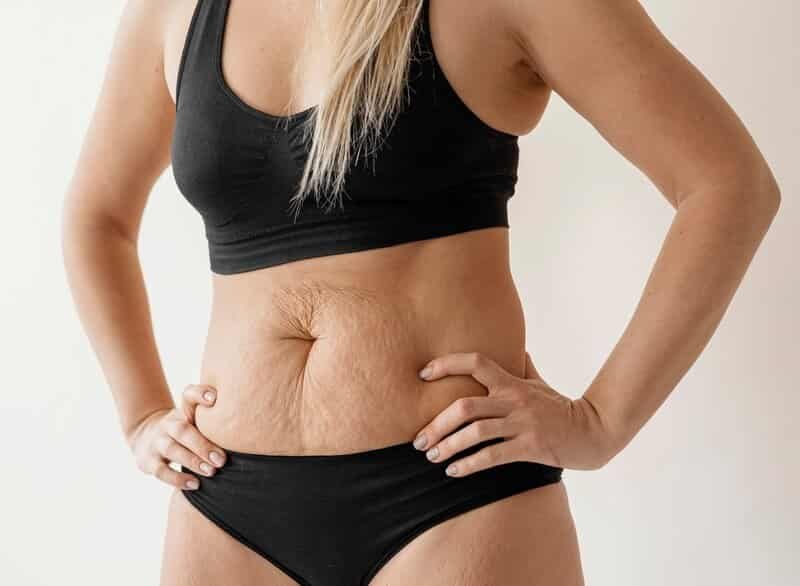In This Article
Introduction
Stretch marks, also known as striae, are those long, narrow streaks or lines that show up on our skin. They happen when the skin stretches quickly due to things like growth spurts, pregnancy, weight gain, or muscle building. Essentially, they’re a type of scar and can appear in various colors, ranging from red or purple to white or silver.
So, what’s going on? Stretch marks occur when the middle layer of our skin, called the dermis, tears because it loses its elasticity due to rapid stretching. Hormonal changes can make this worse by affecting the skin’s collagen and elastin fibers. Here are some common reasons why we get stretch marks:
- Pregnancy: The belly expands rapidly to make room for the growing baby, stretching the skin.
- Adolescence: Those sudden growth spurts during puberty can stretch the skin quickly.
- Weight Fluctuations: Gaining or losing weight quickly can overstretch the skin.
- Bodybuilding: Rapid muscle growth can also stretch the skin.
Weight loss and stretch marks often go hand in hand. When you lose weight, the skin that was stretched from the extra weight might not fully retract, leading to stretch marks. How well your skin bounces back depends on factors like age, genetics, and how quickly you lose weight. A slower, more gradual weight loss may reduce the risk of new stretch marks and help minimize the appearance of existing ones. Plus, maintaining a healthy diet rich in vitamins and staying hydrated can support your skin’s health and elasticity during weight loss.
Understanding Stretch Marks
To understand if you can get stretch marks when you lose weight, let’s first dive into what they are and how they form. Stretch marks happen when the skin stretches quickly, causing the middle layer (dermis) to tear.
The dermis gives our skin its elasticity and support. When it tears, it leaves behind a mark known as a stretch mark. How severe a stretch mark is depends on the depth and width of the tear.
Stretch marks begin as red or purple lines and eventually fade to white or silver.
How Stretch Marks Form
Stretch marks, or striae, show up when the skin stretches rapidly due to growth or weight gain. This quick stretching tears the dermis, exposing deeper skin layers. They start as red or purple lines but can fade to a lighter, silvery color over time.
Skin Elasticity
Skin elasticity is the skin’s ability to stretch and then bounce back to its original shape. This is key for the skin to handle growth and size changes. When skin stretches too much, it can lead to stretch marks.
Collagen and Elastin Fibers
Collagen and elastin are essential proteins for the skin. Collagen gives strength and structure, while elastin allows the skin to stretch and return to its shape. Rapid stretching can damage these fibers, leading to stretch marks as the skin struggles to maintain its shape.
Common Areas Where Stretch Marks Appear
Stretch marks often show up where rapid growth or weight gain happens, like the abdomen, breasts, thighs, hips, buttocks, and upper arms. These areas change significantly in size, especially during puberty, pregnancy, or major weight changes.
Stretch Marks and Weight Loss
Many people wonder if they’ll get stretch marks when they lose weight. The truth is, it depends on a few things, like age, genetics, and how much weight you lose.
Age
As we get older, our skin loses some of its elasticity and ability to bounce back. So, older folks might be more likely to get stretch marks from weight loss compared to younger people. The skin’s reduced elasticity makes it harder to adapt to rapid changes, leading to these marks.
Genetics
Genetics also plays a big role. If your family members have stretch marks, you might be more prone to them, too. Your genes can affect how your skin is structured and how resilient it is, making some people more likely to develop stretch marks.
Amount of Weight Lost
How much weight you lose is another major factor. Rapid and significant weight loss can make your skin stretch quickly, increasing the chance of getting stretch marks. Losing weight gradually might give your skin more time to adjust, reducing the risk of marks.
Understanding these factors can help you manage your expectations and take steps to minimize stretch marks, like moisturizing and maintaining a healthy diet.
Why Stretch Marks Can Occur During Weight Loss
Stretch marks can appear during weight loss because of the rapid changes in your body’s size and shape. When your skin stretches quickly, the collagen and elastin fibers can break, leading to stretch marks. This often happens in areas where fat loss is significant, like your abdomen, thighs, and arms.
Rapid Weight Loss
Losing weight quickly can increase your chances of getting stretch marks. When your body sheds pounds rapidly, your skin might not have enough time to adjust to your new size. This sudden change can make your skin stretch and tear, resulting in stretch marks. Gradual weight loss is usually recommended to give your skin enough time to adapt and reduce the risk of stretch marks.
Changes in Skin Tension
Weight loss can change how much tension is on your skin. As you lose fat, the tension decreases, making your skin sag and stretch in new ways. These changes can contribute to stretch marks, especially if your skin isn’t very elastic.
The Role of Skin Health in Preventing Stretch Marks
Keeping your skin healthy is crucial in preventing stretch marks during weight loss. Hydrated and well-nourished skin has better elasticity and resilience. Regularly moisturizing your skin, eating a balanced diet full of vitamins and minerals, and staying hydrated can all help keep your skin healthy. Also, incorporating strength training and other muscle-building exercises can support your skin and reduce the likelihood of stretch marks.
Factors Influencing Stretch Marks During Weight Loss
When embarking on a weight loss journey, many individuals aim to achieve a healthier and more toned physique. However, it’s important to be aware of the potential for stretch marks, which can develop as the body changes. Understanding the factors that influence the formation of stretch marks during weight loss can help in managing and possibly minimizing their appearance.
Skin Type and Genetics
Your skin type and genetic predisposition can heavily influence the likelihood of developing stretch marks. Some people have more elastic skin, which can stretch and contract without leaving marks, while others may have less elastic skin that is more prone to tearing and scarring. If your family members have stretch marks, you might be more likely to get them, too.
Age and Skin Elasticity
As we age, our skin loses some of its natural elasticity due to the decrease in collagen production. Younger skin tends to be more resilient and can adapt to changes in body size more easily. Older individuals might experience more difficulty with skin adapting to weight changes, making stretch marks more likely during significant weight loss.
Weight Loss Amount and Speed of Reduction
The extent and speed of your weight loss can also play a critical role. Losing a large amount of weight, especially if done rapidly, can put more stress on the skin. This rapid shrinking can cause the skin to stretch and tear, resulting in stretch marks. Gradual weight loss gives the skin more time to adjust, potentially reducing the likelihood of developing stretch marks.
Prevention and Management
Preventing and managing stretch marks during weight loss can feel overwhelming, but some highly effective strategies can help you keep your skin looking great. Here are some tips to help you minimize the risk of developing stretch marks and to treat existing ones effectively
- Gradual weight loss: Rapid weight changes can increase the risk of stretch marks. Aim for a steady, gradual weight loss so your skin has time to adjust. This not only benefits your skin but also helps maintain a sustainable and healthy weight loss.
- Hydration and moisturizing: Keeping your skin hydrated can improve its elasticity, making it less likely to develop stretch marks. Use moisturizers daily to keep your skin soft and supple. Look for products with ingredients like glycerin, hyaluronic acid, and natural oils such as coconut oil to nourish your skin.
- Nutritional support (Vitamins A, C, E, and zinc): Good nutrition is crucial for healthy skin. Vitamins A, C, E, and zinc are particularly beneficial. Include foods rich in these nutrients in your diet to help prevent stretch marks. Think fruits, vegetables, nuts, and seeds.
- Regular exercise and skincare routines: Regular physical activity improves blood circulation, which helps maintain skin elasticity. Combine exercise with a consistent skincare routine. Regular exfoliation removes dead skin cells, and using body oils keeps your skin hydrated and smooth. Massages can also stimulate blood flow and help maintain skin elasticity.
- Treatments for existing stretch marks: If you already have stretch marks, there are treatments available to reduce their appearance:
- Over-the-counter creams and lotions: Products with ingredients like retinoids, hyaluronic acid, and peptides can improve the texture and appearance of stretch marks over time. Consistent application is key.
- Dermatological treatments (laser therapy, microdermabrasion): Professional treatments like laser therapy and microdermabrasion can reduce the visibility of stretch marks by promoting collagen production and skin regeneration. Consult a dermatologist for personalized recommendations.
By incorporating these strategies into your routine, you can effectively manage and minimize the appearance of stretch marks during your weight loss journey. Consistency is key, and a holistic approach to skincare will yield the best results. Embrace the process and take pride in the positive changes you are making for your health!
Here’s a summary table:
| Aspect | Description |
|---|---|
| Cause of Stretch Marks | Rapid stretching of skin causing tears in the dermis (middle layer of skin) |
| Common Areas | Abdomen, breasts, thighs, hips, buttocks, upper arms |
| Stretch Marks During Weight Loss | Can occur due to rapid changes in body size and shape |
| Factors Influencing Stretch Marks | – Age (older skin less elastic) – Genetics (family history) – Amount and speed of weight loss – Skin type and elasticity |
| Prevention Strategies | – Gradual weight loss – Hydration and moisturizing – Nutritional support (Vitamins A, C, E, and zinc) – Regular exercise and skincare routines |
| Treatment Options | – Over-the-counter creams (retinoids, hyaluronic acid) – Professional treatments (laser therapy, microdermabrasion) |
| Role of Skin Health | Healthy, hydrated skin has better elasticity and resilience |
| Timeline for Results | Varies; OTC treatments may take weeks to months, professional treatments can be faster |
Explanation:
- Cause: Stretch marks form when skin stretches rapidly, causing tears in the dermis. This can happen during weight loss as the skin adjusts to the body’s new shape.
- Common Areas: These are typical locations where stretch marks appear, often corresponding to areas of significant fat loss or skin stretching.
- Stretch Marks During Weight Loss: Rapid weight loss can lead to stretch marks as the skin may not have time to adapt to the new body shape.
- Influencing Factors: Age, genetics, and the nature of weight loss all play roles in determining the likelihood of developing stretch marks.
- Prevention Strategies: These methods aim to support skin health and elasticity during weight loss, potentially reducing the risk of stretch marks.
- Treatment Options: Both over-the-counter and professional treatments are available to help reduce the appearance of existing stretch marks.
- Skin Health: Maintaining overall skin health is crucial in preventing and managing stretch marks.
- Results Timeline: The effectiveness of treatments can vary, and it often takes time to see significant improvements in the appearance of stretch marks.
This table provides a comprehensive overview of the key points related to stretch marks and weight loss, offering insights into causes, prevention, and treatment options.
Conclusion
As we wrap up, let’s take a moment to reflect on the key points we’ve covered and how they can help you manage stretch marks effectively. Adopting a holistic approach that prioritizes your overall health can make a real difference.
- Recap of key points: We’ve talked about various methods and treatments to reduce the appearance of stretch marks, such as topical treatments, laser therapies, and maintaining healthy skin through proper hydration and nutrition.
- Encouragement to focus on overall health: Beyond specific treatments, it’s essential to focus on a healthy lifestyle. Regular exercise, a balanced diet, and staying hydrated not only benefit your skin but also improve your general well-being.
- Final thoughts on managing stretch marks with a balanced approach: Combining targeted treatments with lifestyle changes can yield the best results. By taking care of your body as a whole, you’ll enhance your skin’s resilience and reduce the likelihood of developing new stretch marks.
Remember, it’s all about finding a balance that works for you and nurturing your body in the process.
Frequently Asked Questions
1. What causes stretch marks during weight loss?
Stretch marks can show up because the skin stretches and shrinks quickly. When losing weight, your skin might not keep up with the changes, leading to tiny tears in the dermis that become stretch marks.
2. Are some people more prone to getting stretch marks during weight loss?
Absolutely, genetics and skin type matter. If stretch marks run in your family, you may have a higher chance of developing them. Plus, folks with less elastic skin are more prone to these marks.
3. Does age affect the likelihood of developing stretch marks during weight loss?
Yes, age plays a role. Younger skin is usually more elastic and adapts better to changes, while older skin tends to lose elasticity, making it more susceptible to stretch marks.
4. Can the speed of weight loss impact the development of stretch marks?
Definitely. Rapid weight loss can stress the skin, causing it to stretch and tear. Gradual weight loss gives your skin time to adjust, reducing the chances of getting stretch marks.
5. How can I prevent stretch marks while losing weight?
To prevent stretch marks, aim for gradual weight loss, keep your skin hydrated, eat a balanced diet rich in vitamins and minerals, and stick to a consistent skincare routine that includes moisturizing and exfoliation.
6. What role does hydration play in preventing stretch marks?
Hydrated skin is more elastic and less likely to tear. Drink plenty of water and use moisturizers daily to keep your skin soft and supple, which helps reduce the risk of stretch marks.
7. Are there specific nutrients that can help prevent stretch marks?
Yes, nutrients like vitamins A, C, E, and zinc are great for skin health. Include foods rich in these nutrients in your diet to help prevent stretch marks.
8. Can regular exercise help in preventing stretch marks?
Regular exercise boosts blood circulation, which helps maintain skin elasticity. Combine exercise with a proper skincare routine to further prevent stretch marks.
9. What treatments are available for existing stretch marks?
There are several options to reduce the appearance of existing stretch marks, including over-the-counter creams and lotions with ingredients like retinoids and hyaluronic acid, as well as professional treatments like laser therapy and microdermabrasion.
10. How do over-the-counter creams work on stretch marks?
OTC creams usually contain ingredients like retinoids, hyaluronic acid, and peptides that can improve the texture and appearance of stretch marks over time. Regular use is essential for optimal results.
11. What professional treatments can help reduce stretch marks?
Professional treatments like laser therapy and microdermabrasion help promote collagen production and skin regeneration, which can significantly reduce the visibility of stretch marks. Consult a dermatologist for personalized advice.
12. How long does it take to see results from stretch mark treatments?
The timeline varies depending on the treatment and your skin. OTC topical treatments might take several weeks to months, while professional treatments can show results faster. Remember, consistency and patience are crucial.

Florence
Florence Delisy is a dedicated skincare and beauty expert with extensive industry experience. Certified in skincare and cosmetology from University of the Arts London, she specializes in personalized skincare routines, anti-aging treatments, and beauty consultations. Florence is committed to helping clients achieve healthy, radiant skin through tailored solutions and education on effective skincare practices.







